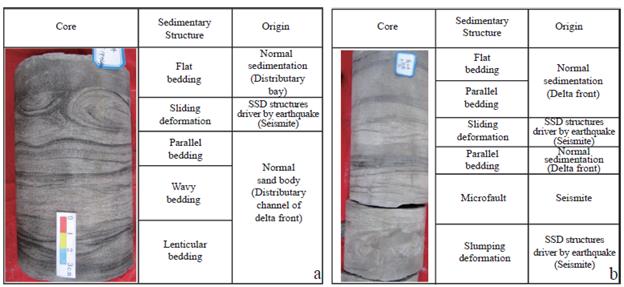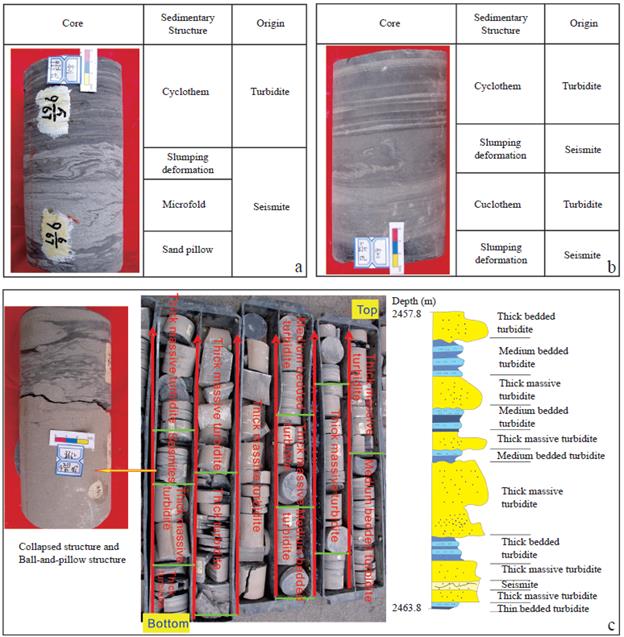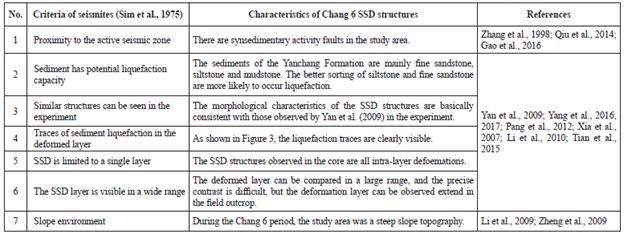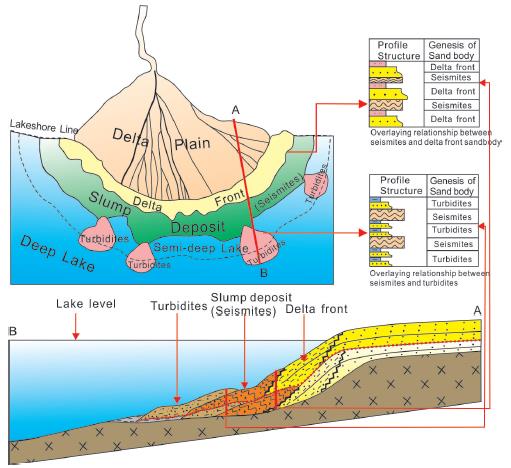Introduction
Soft-sediment deformation (SSD) structures and the architecture of sand bodies can provide information on depositional history and reveal aspects of basin evolution. SSD structures are related to liquefaction and fluidization. Liquefaction and fluidization can be induced by many natural processes, including earthquakes, overloading, unequal loading, and impulsive stresses (Allen,1982; Owen, 1987). Whatever the trigger mechanism, the cause of the SSD structures can be attributed to a decrease in shear resistance in water-saturated and unconsolidated sediments (Moretti and Sabato, 2007). The intensity of the trigger mechanism, the physical properties of the sediments, and the sedimentary environment determine the types and scales of SSD structures. Because of the diversity of trigger mechanisms, it is particularly important to determine their origin. Thus, is it possible to distinguish SSD structures produced by seismic and non-seismic causes? The distinguishing criteria, proposed and elucidated by Sims (1975), Owen and Moretti (2011) and Liu et al. (2016) used to identify paleo-earthquakes are as follows: (i) SSD structures are deformed in a tectonically active basin near an active fault, (ii) SSD structures occur in the vertical direction, separated by undeformed beds, and are developed continuously in the lateral direction, (iii) the morphologies of SSD structures are comparable to SSD structures confirmed from active earthquake belts, (iv) SSD structure types occur in complex combinations, (v) both deformed and undeformed beds develop in similar lithologies and depositional environments (Montenat and Sabato, 2007; Owen and Moretti, 2011; Liu et al., 2016). SSD structures related to seismically induced liquefaction or fluidization are seismites (Seilacher, 1969, 1984). Layers that record paleo-earthquakes have been analyzed by many researchers and reported from many areas in various sedimentary environments, particularly lacustrine (Scott and Price, 1988; Rodríguez-Pascua et al., 2000; Becker et al., 2002). The presence of coarse sediments can be indicative of rapid deposition in a slumping environment. Coarse sediments mainly develop via processes of mass transport, e.g., slumping, sandy debris flows, and turbidites, or with over-steepening of depositional slopes (Owen and Moretti, 2011; Oliveira et al., 2011; Van Loon and Pisarska-Jamrozy, 2014). Rapid sedimentation can only be preserved where the overlying sediments are thick and massive and have a uniform grain size. The theory of seismogenesis has been frequently quoted as the most appropriate for the interpretation of numerous SSD structures (Papadopoulos and Lefkopoulos G, 1993; Tuttle and Schweig, 1996; Alfaro et al., 2002; Bachmann and Aref, 2005; Montenat et al., 2007; Zhang et al., 2007; Obermeier, 2009; Ghosh et al., 2010; Moretti and Ronchi, 2011; Brandes and Winsemann, 2013; Van Loon and Pisarska-Jamrozy, 2014; Liu et al., 2016 ; Onorato et al., 2016).
This study aims to identify typical SSD structures in the Chang 6 oil member of the Yanchang Formation of the Southwestern Ordos Basin, based on a large number of research results on the characteristics of seismites, include their identification marks and classification, and analysis of the types and characteristics of the SSD structures and their sedimentary environments (Montenat, 2007). Moreover, the difference between SSD structures formed by a paleo-seismic event and a gravity slump is analyzed. The architecture of sand bodies from different genesis are studied to build a genetic model of sand bodies occurring from different sedimentation processes in the study area. These methods could be beneficial in further analysis of the southwestern Ordos Basin and oil-gas exploration in the area.
Geological setting
The Mesozoic-Cenozoic Ordos Basin is the second-largest sedimentary basin in China, developed on the Paleozoic North China Craton atop a Proterozoic crystalline basement (Qiu et al., 2014). Tectonically, it can be subdivided into the following eight major structural units: the West Margin Thrust Belt; Tianhuan Depression; Yishan Slope; Jinxi Fault-fold Belt; Lvliangshan Fault-fold Belt; Yimeng Uplift; Weibei uplift; and Weihe Graben (Figure 1). The study area is on the southwestern Yishan Slope, which is mainly in the central Ordos Basin.
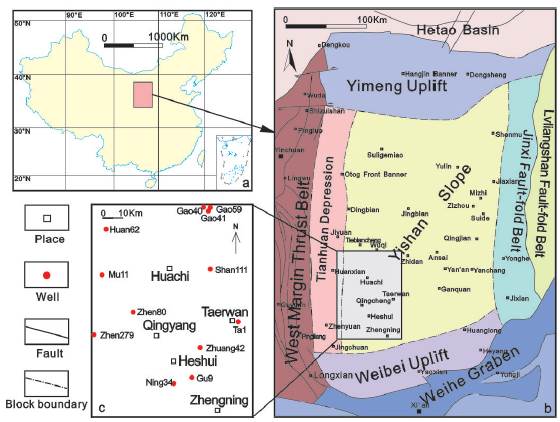
Figure 1 Regional location of study area. (a) Location of the Ordos Basin, China; (b) Geological setting of the study area and periphery; (c) Well location of the case studies in the study area illustrated the present paper.
To better establish the stratigraphic relationships, the PetroChina Changqing Oilfield Company subdivided the Yanchang Formation into 10 informal oil members, named Chang 10 to Chang 1 (from bottom to top) based on marker beds, sedimentary cycles or lithological associations (Qiu et al., 2015) (Figure 2). The Upper Triassic Yanchang Formation is dominated by alluvial fan, alluvial plain, deltaic, fluvial and lacustrine complexes that are composed of sandstones, siltstones, mudstones and tuff intercalations, with a thickness of approximately 1000-1300 m (Figure 2) (Qiu et al., 2014).
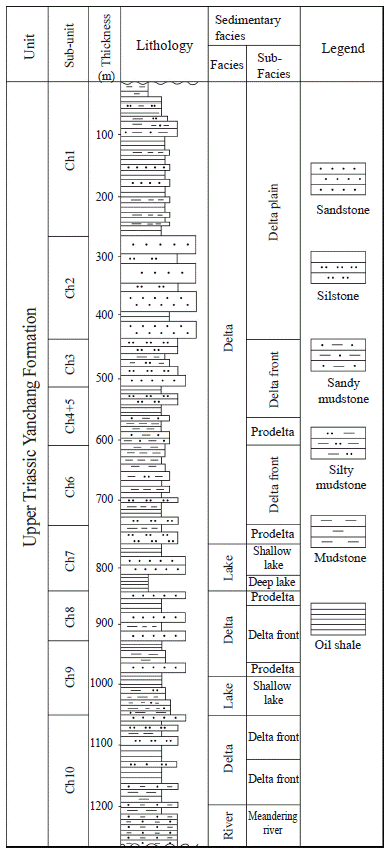
Figure 2 Stratigraphic column of the Upper Triassic Yanchang Formation in the Ordos Basin (Ch=Chang, modified from Qiu et al., 2015).
The sedimentary environment of the Chang 6 oil member in the Huachi-Qingyang (H-Q) area is a delta front and shallow lake. It is among the most significant Mesozoic oil-bearing strata, with oil reserves reaching more than 70% of the proved geological oil reserves and crude oil output in the Mesozoic Ordos Basin (Qiu et al., 2015).
SSD structure types
Various SSD structures, related to paleo-seismic events and gravity slumps, are developed in the Chang 6 oil member of the Upper Triassic Yanchang Formation in the H-Q area of Ordos Basin. These SSD structures can be divided into five categories based on morphologic and deformational type: ball-and-pillow structures, fold structures, sand dikes, irregular convolute stratifications, and synsedimentary faults. There are described and interpreted as follows.
Ball-and-pillow structures
Ball-and-pillow structures are the most numerous SSD structures in the Chang 6 oil member in the study area. Under the action of earthquakes and gravity, balls or pillows composed of fine-grained sandstone fall into underlying muddy layers, and ball-and-pillow structures are formed. Both the overlying and the underlying layers exhibit liquefaction phenomena (Figure 3-a). Portions of dense overlying liquefied sediments can become completely separated balls and pillows from the parent rock, and the diameter of individual balls and pillows range from 1 to 5 cm, although they can remain interconnected each other floating in the underlying less dense sediment.
The ball-and-pillow structures are associated with seismic action, and they can be interpreted to be driven by downslope slumping, but most results from loading processes related to variations in gravitational potential energy and are driven by variations in bulk density (Calvo et al., 1998). Factors that favor the development of sand ball-and-pillow structures, in contrast to load casts that affect the base of a laterally continuous bed, include a driving force of large magnitude, a combination of driving forces, a very weak lower layer, or a long duration of deformation.
Fold structures
Fold structures are common in the upper part of the Yanchang Formation. These SSD structures are mainly represented by obvious folds occurring in layers of siltstone and mudstone strips and form a series of different forms of small folds that fluctuate in a wave and groove shape, equivalent to "seismic corrugated rock," as termed by Qiao et al. (1994). Fold structures are more typically shown in the Zhen-80 well (Figure 3-b) and Ta-17 well (Figure 3-e).
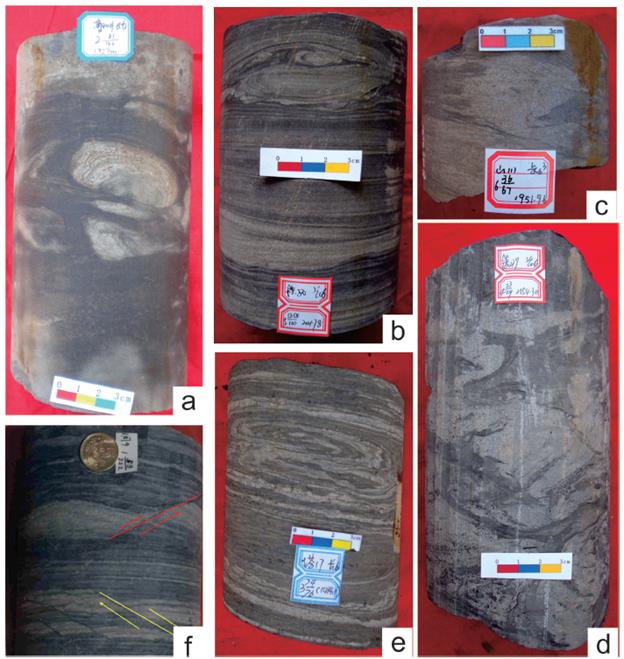
Figure 3 Types and features of SSD structures in the study area. (a) Ball-and-pillow structure from the Gao^W well, Chang 6 oil member, 1927.00-1927.35 m. (b) Fold structures from the Zhen-80 well, Chang 6 oil member, 2021.49-2021.78 m. (c) Sand dikes from the Shan-111 well, Chang 6 oil member, 1951.87-1951.96 m. (d) Irregular convolute stratifications from the Zhen-279 well, Chang 6 oil member, 2154.30-2154.72 m. (e) Fold structures from the Ta-17 well, Chang 6 oil member, 1433.95-1434.10 m. (f) Synsedimentary faults developing in two opposite directions from the Gu-9 well, Chang 6 oil member, 1679.00-1679.28 m.
The fold structures can be interpreted as ductile deformation; however, asymmetric geometry and overturned folds in the study area suggest that the deformation occurred in a hydroplastic manner rather than a ductile deformational process (Martín-Chivelet et al., 2011). The sedimentary environment of the Chang 6 strata is lacustrine, and hydroplastic deformation can occur via downslope movement of sediments (slump fold). The fold structures are characterized by laterally continuous layers, which are underlain and overlain by undeformed beds with an irregular and transitional boundary. According to the well cores, most of the folded layers are 3-6 cm thick (up to 10 cm in thickness) and consist of thick sandstone and relatively thin mudstone layers. Internally, individual folded beds or laminae have an asymmetric geometry with different vergences in a single folded layer.
Sand dikes
Sand dikes are composed of homogeneous liquefied sandstone injected into existing cracks. During the deformational process, small-sized breccias might dislodge from the surrounding rock and float within the sand sediment. Sand dikes are more typically observed in the Shan-111 well (Figure 3-c).
Sand dikes refer to sandy veins or dikes developed in the interbedded sediments of sand and mudstone. They are stretched in an irregular shape and cut the horizontal bedding of the adjacent rock. The sand dikes are vertical or oblique to the bedding, a few of which are nearly parallel to the bedding. Sand dikes differ in size, with widths generally ranging from 0.2 to 5 cm and lengths from 1 cm to dozens of centimeters. The shapes are also varied, and are often represented by irregular vein, plate or worm shapes. Some are larger in the middle part, thinning towards the two ends before wedging out, and are bifurcated. There is no uniform shape on the surface, while some are larger in the upper part instead of the lower part. The dike body is bent when it cuts through the surrounding rock, and is particularly convex in the upper part and concave in the lower part.
Irregular convolute stratifications
Irregular convolute stratifications are structures induced by the liquefaction of sediments (Liu et al., 2016). Irregular convolute stratifications are generally present in fine-to-medium-grained sandstone. The morphology they exhibited is highly distorted stratification, and they more typically occur in the Zhen-279 well (Figure 3-d).
The irregular convolute stratifications can be interpreted as liquefaction of sediments, and the morphologies of irregular convolute stratifications are similar to synsedimentary faults, but the liquefied degree represented by the two structure types is very different. Irregular convolute stratifications always found in fine-medium-grained sandstone, sometimes mixed with coarse sandstone.
Synsedimentary faults
Small-scale synsedimentary faults are mainly observed in the Chang 6 oil member, and typically occur in the Gu-9 well (Figure 3-f). These faults, which show a few centimeters of displacement along their lengths of <6 cm, truncate at both the overlying and underlying coarse-grained sandstone beds. These faults display pairs of conjugate geometry.
Synsedimentary faults generally represent brittle deformation; however, they occur in consolidated, partially consolidated, and even non-consolidated sediments. In particular, the dragged layer and dis clasts in the reverse fault zone indicate that they were incompletely lithified at the time of faulting and truncate only the restricted layer. Thus, synsedimentary faults may result from different physical properties during plastic deformation. In addition, the coexistence of both normal and thrust faults can be interpreted as a result of local extension and compression.
Differences between the SSD structures induced by Earthquakes and Gravity Slumps
The SSD structures developed in the Chang 6 oil member of Yanchang Formation in the study area are limited to a single layer, of which the upper and lower parts are non-deformational layers, showing synsedimentary deformation controlled by geological events. Generally, there are only two driving mechanisms in a lacustrine environment, namely earthquakes and underwater gravity slumps.
The main differences between the two mechanisms are shown as follows:
i) Because an underwater landslide is controlled by the basin slope, its SSD structures have a dominant orientation.
ii) Underwater gravitational slidings are allogenic deposits with a base sliding surface, different from the non-deformational layers, and the SSD structure caused by seismic activity occurs in the in situ formation.
iii) Seismic activities may form a uniform liquefaction layer, while a slump cannot. As recognized as a sign of SSD structures induced by earthquakes, uniform liquefaction layers are under the water and the sedimentary surface. They are liquefied during the shake of an earthquake, and the primary beddings are destroyed. Following the seismic activity, the normal sedimentation of the water body is recovered, and the primary stratification appears again. The uniform layer and overlying non-earthquake layer in the Ta-17 well are well preserved (Figure 3-e). In addition, the movement direction of the landslide is consistent with the direction of the paleoslope, while there is no clear correspondence between the movement direction of deformation driven by an earthquake and slope direction (Zhang et al., 2007).
The SSD structure stratum developed in the Chang 6 oil member of Yanchang Formation in the study area is consistent with the upper and lower non-deformational strata in terms of lithology, rock association and sedimentary environment, which contradicts the SSD structures formed by a landslide.
Moreover, the two sets of synsedimentary faults found in well Gu 9 break in two opposite directions (Figure 3-f), which indicates that the formation of the fault is not controlled by the paleoslope. If the fault direction is related to the paleoslope, the faults break towards the direction of slope. The fault should be formed under the seismic tensile stress of two seismic events that occur within a short time interval, and the focus of the two seismic events should also be different.
Based on the aforementioned principles, and from all the systematic research on the relationship between SSD structures and depositional environment and paleoslope, it was determined that a seismic event was the driving mechanism for the formation of the SSD structures in the Chang 6 oil member.
Different types of sand body architecture
Under the influences of two driving mechanisms in a lacustrine environment, two types of sand body architecture can form as follows: i) SSD structures driven by a seismic event with delta front sand body (SD-SSD) and ii) SSD structures driven by seismic event with turbidites (ST-SSD).
Architecture of SD-SSDs
For the architecture of the sand bodies in the study area, the layer with the SSD structures is interbedded with the normal delta front sedimentary sand body in a vertical direction (Figure 4-a, 4-b). This is because the material source of the sand bodies with SSD structures are the delta front sand bodies, which formed by liquefaction during seismic activities. During the period between two seismic events, SSD structures overlaid the delta front sand body formed by normal deposition, resulting in a superimposed composite feature of SSD structures formed by the seismic event and a normal delta deposit sand body during the sedimentary evolutionary phase (Figs. 4-a, 4-b).
Architecture of ST-SSDs
During the sedimentary evolution of the Chang 6 oil member in the H-Q area, not only were SSD structures developed related to paleo-seismic events, but turbidite sand body also developed which widely formed via the deposition of turbidity currents (especially in Qingyang, Guchengchuan, Heshui, and Ningxian). These two aforementioned deposited sand bodies are subject to vertical superimposition and horizontal close intergrowth, forming a superimposed composite sand body of the sedimentary body of seismic event genesis and a sand body resulting from a turbidity current (Figure 5-a, 5-b, 5-c).
Discussion
Mechanism of deformation
There are three sand body types were developed during the sedimentary evolution of the Chang 6 oil member in the H-Q area in the central Ordos Basin. Including i) sand body include SSDs related to paleoseismic events, ii) turbidite sand bodies formed by turbidity events, and iii) delta front sand bodies. These three sand body types are superposed vertically and closely coexist on the plane, which constitute the superposition of paleoseismic event sediments, turbidity event sediments and delta front sediments. Although they are different in characteristics and genetic mechanism, the causes of their formation are closely related.
There is general agreement that SSD structures as described maybe caused by liquefaction of sediments induced by seismic shock. According to the criterion of the seismites summarized by Sim (1975), compared with the characteristics of Chang 6 SSD structures:
The Chang 6 SSD structures meet these seven criteria, and they are most likely due to seismic shock. In addition, turbidites are widely developed in the Chang 6 oil member in the southern Ordos Basin. The turbidites also develop SSD structures such as ball-and-pillow structures, fold structures, sand dikes and irregular convolute stratifications, during the deposition process. Some former researchers have seen typical phenomena of turbidity deposition in the SSD layer or in the adjacent layer of the study area, such as grain-order bedding or bog sequenced, indicating that SSD structures will also occur during turbidity deposition (Montenat et al., 2007). This is not inconsistent with the statement that the seismic caused the SSD structures in the study area, because the seismic is an important factor in triggering gravity flow.
Sedimentary model
It can be observed from the regional depositional setting that during the Chang 6 sedimentary period, the H-Q area was exactly at the superimposition part of the northeastern delta front and the southwestern delta front (Fu et al., 2005). The Ordos Basin began to contract and the delta kept expanding towards the lake basin via progradation, carrying a large number of terrigenous clasts to the lake basin. Because of the vibrations caused by seismic action, the unstable irregular lobate body of the delta front may have collapsed and formed seismite first, and the top of the seismite could have transformed into a turbidite body due to gravity. The aforementioned process can recur when new seismic events occur, which results in a vertical superimposition and horizontal intersection of the SSD structural layer related to the paleo-seismic event and the sand body formed by a normal delta front and turbidity current deposition (Figure 6).
Conclusions
(1) Various earthquake-related SSD structures developed in the Chang 6 oil member sand body in the H-Q area in the central lake basin during the depositional stage of the Chang 6 oil member of the Triassic Yanchang Formation in the Ordos Basin. These mainly included ball-and-pillow structures, fold structures, sand dikes, irregular convolute stratification and synsedimentary faults.
(2) The obvious distinctions between the SSD structures formed by paleo-seismic events and SSD structures resulting from gravity slumps mainly are apparent in three aspects, including dominant orientation of the SSD structures, the existence of a glide plane and the existence of a uniform liquefaction layer.
(3) The sand body architecture formed between the SSD structural layer resulted from paleo-seismic events and those of other genetic types, which mainly includes two types: i) SSD structures driven by seismic events with delta front sand body and ii) SSD structures driven by seismic events with turbidite sand bodies formed by a delta-front slumping and redistribution due to seismic action.













